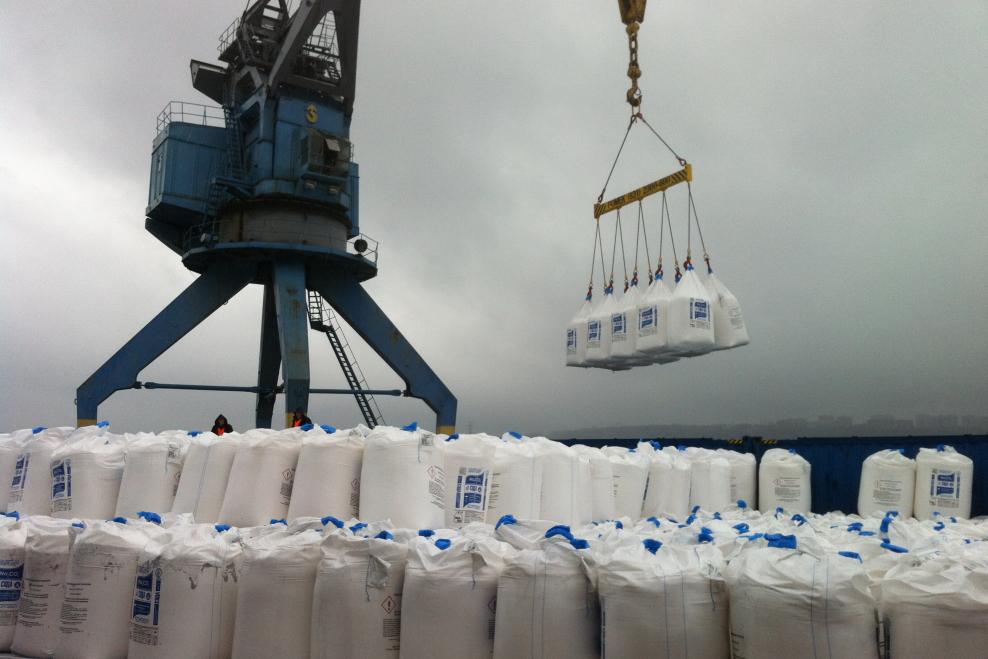The ports of the Caspian and Azov-Black Sea basins showed a 1.6 times volume growth in January

The total volume of dry bulk cargo handled during the month was 32.8 million tonnes (-5.8%), including: 14.4 million tonnes of coal (-14.3%), 5.4 million tonnes of grain (+0.1%), 4.2 million tonnes of containerized cargo (+5.5%), 3.3 million tonnes of mineral fertilizers (+32.4%), 1.6 million tonnes of ferrous metals (-5.8%), 0.5 million tonnes of ore (-20.1%), and 0.5 million tonnes of cargo on ferries (-15.1%).
The total volume of liquid bulk handled last month at the country’s ports fell 6.5% year-on-year, to 38.2 million tonnes. This includes: 23.2 million tonnes of crude oil (-3.4%), 10.6 million tonnes of oil products (-18%), 3.4 million tonnes of LNG (+13.3%), and 600 000 tonnes of food cargo (+11.3%).
Handling of exports declined in January by 6% to 55.9 million tonnes. Imports volume edged down 1% to 3.2 million tonnes, while transit cargo volume rose 5.8% to 6.2 million tonnes and short sea traffic cargo increased by 15% to 5.8 million tonnes.
The Arctic Basin Seaports:
The volume of cargo handled at the region’s ports reached 7.8 million tonnes (-5.4%), including dry bulk segment: 2 million tonnes (-13.8%), liquid bulk: 5.8 million tonnes (-2.1 %). The ports of Murmansk throughput was 4.4 million tonnes (-13.2%), of Sabetta: 2.6 million tonnes (+11.3%), of Varandey: 500 000 tonnes (unchanged Y/Y) and Arkhangelsk: 100 000 tonnes (-6.1%).
The Baltic Basin Seaports:
Handling of cargo at the seaports decreased by 4.3% on the same month a year earlier, to 21.6 million tonnes. This figure included dry bulk cargo volume which rose 17.7% reaching 9.7 million tonnes, liquid bulk cargo volume dropped 17% to 11.9 million tonnes. Cargo volume at these ports was the following: a 22.6-percent decline in Ust-Luga to 9 million tonnes, Primorsk: 6.2 million tonnes (+3.4%), Great Port of St. Petersburg: 4.4 million tonnes (+43.9%), Vysotsk: 1.2 million tonnes (+1.9%).
The Azov-Black Sea Basin Seaports:
Cargo traffic the southern seaports amounted to 24 million tonnes (-7.1%), including dry bulk cargo: 10.6 million tonnes (-13.8%), liquid bulk cargo: 13.4 million tonnes (-0.9%). The Port of Novorossiysk handled 14 million tonnes (-1.5%), Taman: 3.5 million tonnes (-16.2%), Tuapse: 2 million tonnes (-9.9%), Port Kavkaz: 1.5 million tonnes (-10%), Rostov-on-Don: 1.1 million tonnes (-18.1%).
The Caspian Basin Seaports:
The volume of cargo handled at the region’s ports in January reached 0.7 million tonnes (a 1.6 times growth), of which the volume of dry bulk cargo rose two-fold to 10 million tonnes, liquid bulk cargo: 0.2 million tonnes (-0.3%). Throughput at the Port of Astrakhan surged 1.8 times year-on-year to 400 000 tonnes, the Port of Makhachkala handled 300 000 tonnes (+11.5%),
The Far Eastern Basin Seaports:
The volume of handled cargo was 16.9 million tonnes (-9.1%), including dry bulk: 10 million tonnes (-14.5%), liquid bulk: 6.9 million tonnes (+0.2 %). Throughput figures of the Far Eastern ports were the following: Vostochny: 7 million tonnes (-8.1%), Vanino: 1.6 million tonnes (-42%), Vladivostok: 2.8 million tonnes (+2.7%), Nakhodka: 2.2 million tonnes (-0.3%), Prigorodnoye: 1.3 million tonnes (-1.8%).
Passenger Traffic:
The ports’ terminals handled in January 1 407 passenger and cruise ships (a 2.6 times drop) and 53 600 passengers (a 4.1 times decline). This includes the number of passengers of departing ships: 26 300 people (a 4.2 decrease), and of arriving ships: 27 300 people (a four-fold drop). There were no transit passengers in the reporting period.
The main number of passengers in 2023 were served at dedicated passenger terminals in the following seaports – of Sevastopol: 41 900 people (a 4.8 times decline), Sochi: 8 800 people (a 2.1 times growth), Vladivostok: 2 100 people (a 27.7 times decrease).



